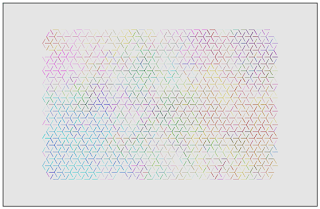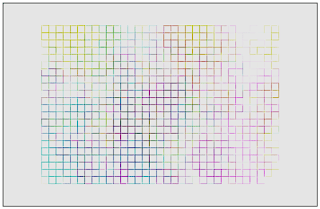Creative coding artwork with the random walking paths with three primary colors.
Description of this creative coding artwork.
It's a creative coding artwork made with Processing featuring a Random Walk. It draws random walking paths with three primary colors.
It's a derivative work of 'Processing code example of walking on the grid.'.
When I was playing with a Random Walk, I found three primary colors of light turn to the trichromatic with blendMode(DIFFERENCE).
It creates various colors with mixing trichromatic. It looks nice, so I decided to make something with this.
The key of this code is drawing with vertex();. I skipped endShape() turn like this.
int modCnt = stepCnt % (corners - 1);
if (modCnt == 0) beginShape();
~
vertex(wX, wY);
~
if (modCnt == 1) endShape();
If you do not skip, you get no filling colors.
beginShape();
vertex(wX, wY);
endShape();
But I liked this no filling results. So I added random choice of fill() or noFill().
float fillAlp = (random(1.0) < 0.25) ? 0.0 : 100.0; // fill or not fill randomly
A example code of the 'Processing'.
This code does not display any images on the screen but generates image files in frames directory.
Please feel free to use this example code under the terms of the GPL.
To see other works based on my code is my pleasure. And my honor.
/**
* Mixin' the Colors.
* A random walk on the grid with three primary colors.
*
* Processing 3.5.3
* @author @deconbatch
* @version 0.1
* created 0.1 2020.06.06
*/
void setup() {
size(980, 640);
colorMode(HSB, 360, 100, 100, 100);
rectMode(CENTER);
smooth();
noLoop();
}
void draw() {
int corners = 3; // initial corners of the shape
int patternMax = 3; // draw 3 patterns
strokeJoin(ROUND);
translate(width * 0.5, height * 0.5);
for (int pattern = 0; pattern < patternMax; pattern++) {
corners += pattern; // 3, 4, 6
int walkerMax = 9;
int stepMax = corners * 200;
float sideLen = 8.0 - pattern * 2.5;
float fillAlp = (random(1.0) < 0.25) ? 0.0 : 100.0; // fill or not fill randomly
strokeWeight(corners * corners * corners * random(0.01, 0.05));
// set walker
ArrayList<Walker> walkers = new ArrayList<Walker>();
for (int i = 0; i < walkerMax; i++) {
float wX = sideLen * corners * i - (sideLen * corners * walkerMax) * 0.5;
float wY = 0.0;
float wS = random(80.0, 100.0);
float wB = random(0.0, 40.0);
float wD = TWO_PI / corners;
int wR = floor(random(corners));
walkers.add(new Walker(wX, wY, 0.0, wS, wB, wD, wR)); // cyan
walkers.add(new Walker(wX, wY, 120.0, wS, wB, wD, wR)); // magenta
walkers.add(new Walker(wX, wY, 240.0, wS, wB, wD, wR)); // yellow
}
// draw walker
blendMode(BLEND);
background(0.0, 0.0, 90.0, 100.0);
blendMode(DIFFERENCE);
for (Walker walker : walkers) {
float wX = walker.x;
float wY = walker.y;
float wC = walker.hueVal;
float wS = walker.satVal;
float wB = walker.briVal;
float wD = walker.radianDiv;
float wR = walker.rotateCnt;
stroke(wC, wS, wB, 60.0);
fill(wC, wS, wB, fillAlp);
// random walk
for(int stepCnt = 0; stepCnt < stepMax; stepCnt++) {
/*
* Key of this code!
* if (modCnt == 0) beginShape();
* if (modCnt == 1) endShape();
*/
int modCnt = stepCnt % (corners - 1);
if (modCnt == 0) beginShape();
for (int j = 0; j < corners; j++) {
wX += sideLen * cos(wR * wD);
wY += sideLen * sin(wR * wD);
vertex(wX, wY);
}
if (modCnt == 1) endShape();
if (abs(wX) < width * 0.35 && abs(wY) < height * 0.35) {
if (random(1.0) < 0.5) {
--wR; // not turn
} else {
if (random(1.0) < 0.1) {
wD *= -1.0; // turn
}
}
}
++wR;
wR %= corners;
}
}
blendMode(BLEND);
casing();
saveFrame("frames/" + String.format("%04d", pattern + 1) + ".png");
}
exit();
}
/**
* casing : draw fancy casing
*/
private void casing() {
fill(0.0, 0.0, 0.0, 0.0);
strokeWeight(20.0);
stroke(0.0, 0.0, 0.0, 100.0);
rect(0.0, 0.0, width, height);
strokeWeight(15.0);
stroke(0.0, 0.0, 100.0, 100.0);
rect(0.0, 0.0, width, height);
}
/**
* Walker : hold random walker attributes
*/
private class Walker {
public float x, y;
public float hueVal, satVal, briVal;
public float radianDiv;
public int rotateCnt;
Walker(float _x, float _y, float _c, float _s, float _b, float _d, int _r) {
x = _x;
y = _y;
hueVal = _c;
satVal = _s;
briVal = _b;
radianDiv = _d;
rotateCnt = _r;
}
}
/*
Copyright (C) 2020- deconbatch
This program is free software: you can redistribute it and/or modify
it under the terms of the GNU General Public License as published by
the Free Software Foundation; either version 3 of the License, or
(at your option) any later version.
This program is distributed in the hope that it will be useful,
but WITHOUT ANY WARRANTY; without even the implied warranty of
MERCHANTABILITY or FITNESS FOR A PARTICULAR PURPOSE. See the
GNU General Public License for more details.
You should have received a copy of the GNU General Public License
along with this program. If not, see <http://www.gnu.org/licenses/>
*/
I can play with the Node Garden also.














